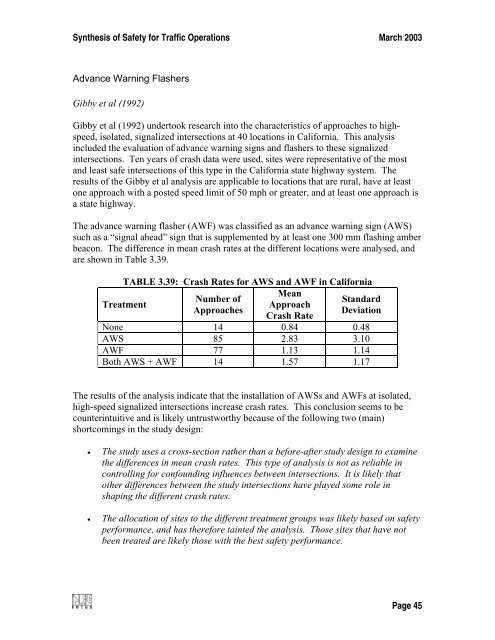Synthesis of Safety for Traffic Operations - Transports Canada
Synthesis of Safety for Traffic Operations - Transports Canada
Synthesis of Safety for Traffic Operations - Transports Canada
You also want an ePaper? Increase the reach of your titles
YUMPU automatically turns print PDFs into web optimized ePapers that Google loves.
<strong>Synthesis</strong> <strong>of</strong> <strong>Safety</strong> <strong>for</strong> <strong>Traffic</strong> <strong>Operations</strong> March 2003<br />
Advance Warning Flashers<br />
Gibby et al (1992)<br />
Gibby et al (1992) undertook research into the characteristics <strong>of</strong> approaches to highspeed,<br />
isolated, signalized intersections at 40 locations in Cali<strong>for</strong>nia. This analysis<br />
included the evaluation <strong>of</strong> advance warning signs and flashers to these signalized<br />
intersections. Ten years <strong>of</strong> crash data were used, sites were representative <strong>of</strong> the most<br />
and least safe intersections <strong>of</strong> this type in the Cali<strong>for</strong>nia state highway system. The<br />
results <strong>of</strong> the Gibby et al analysis are applicable to locations that are rural, have at least<br />
one approach with a posted speed limit <strong>of</strong> 50 mph or greater, and at least one approach is<br />
a state highway.<br />
The advance warning flasher (AWF) was classified as an advance warning sign (AWS)<br />
such as a “signal ahead” sign that is supplemented by at least one 300 mm flashing amber<br />
beacon. The difference in mean crash rates at the different locations were analysed, and<br />
are shown in Table 3.39.<br />
TABLE 3.39: Crash Rates <strong>for</strong> AWS and AWF in Cali<strong>for</strong>nia<br />
Treatment<br />
Mean<br />
Number <strong>of</strong><br />
Standard<br />
Approach<br />
Approaches<br />
Deviation<br />
Crash Rate<br />
None 14 0.84 0.48<br />
AWS 85 2.83 3.10<br />
AWF 77 1.13 1.14<br />
Both AWS + AWF 14 1.57 1.17<br />
The results <strong>of</strong> the analysis indicate that the installation <strong>of</strong> AWSs and AWFs at isolated,<br />
high-speed signalized intersections increase crash rates. This conclusion seems to be<br />
counterintuitive and is likely untrustworthy because <strong>of</strong> the following two (main)<br />
shortcomings in the study design:<br />
• The study uses a cross-section rather than a be<strong>for</strong>e-after study design to examine<br />
the differences in mean crash rates. This type <strong>of</strong> analysis is not as reliable in<br />
controlling <strong>for</strong> confounding influences between intersections. It is likely that<br />
other differences between the study intersections have played some role in<br />
shaping the different crash rates.<br />
• The allocation <strong>of</strong> sites to the different treatment groups was likely based on safety<br />
per<strong>for</strong>mance, and has there<strong>for</strong>e tainted the analysis. Those sites that have not<br />
been treated are likely those with the best safety per<strong>for</strong>mance.<br />
Page 45
















